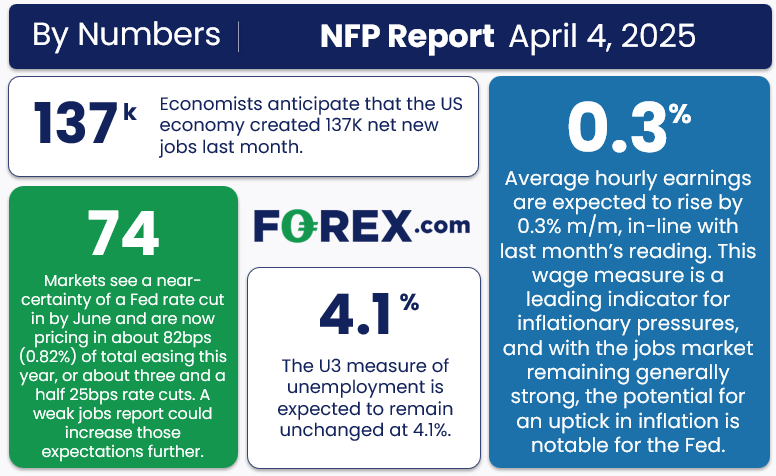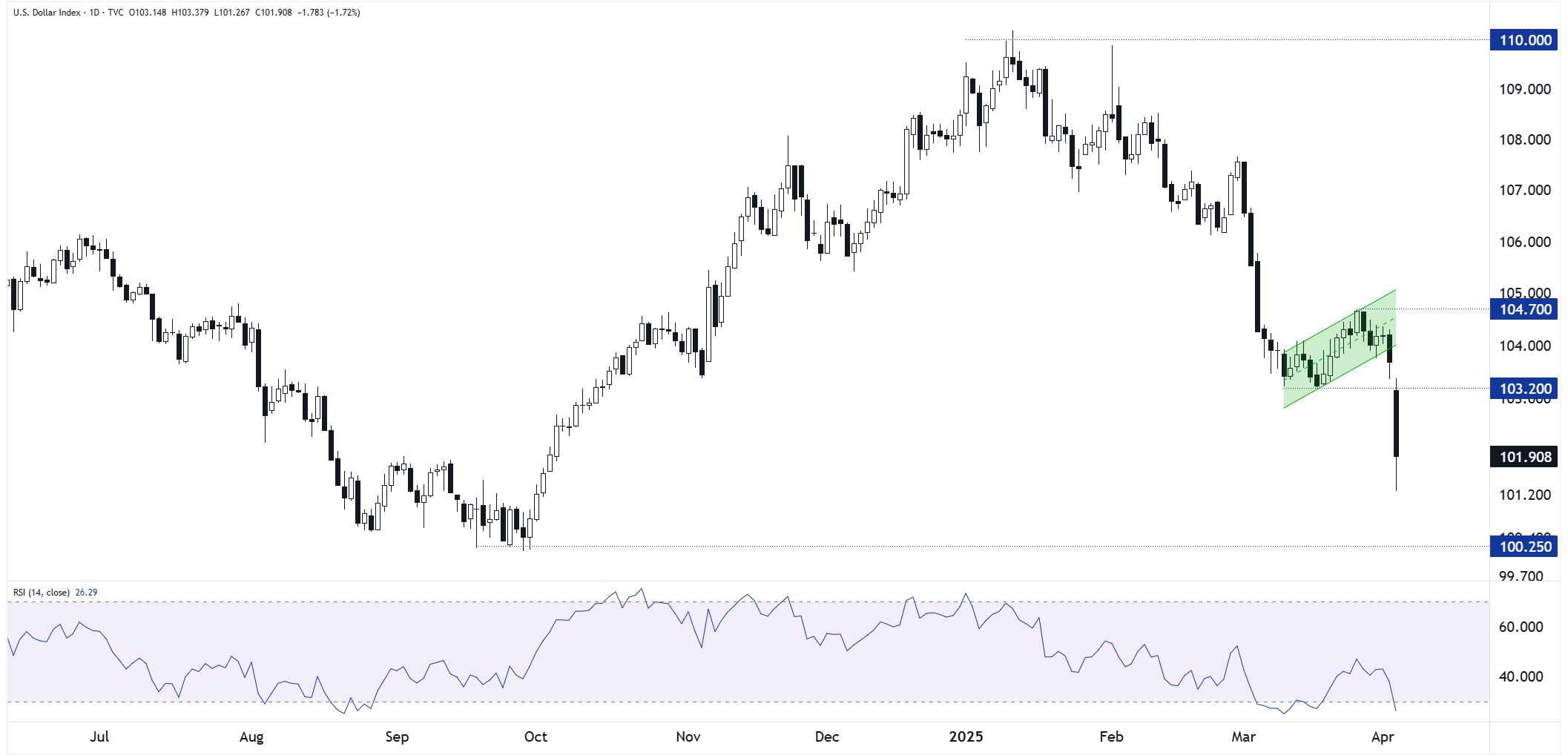- NFP report expectations: +137K jobs, +0.3% m/m earnings, unemployment at 4.1%
- Leading indicators point to near-expectation reading in this month’s NFP report.
- Headline job growth is potentially coming in somewhere in the 135-165K range.
- The greenback is deeply oversold, but given we’re in the midst of the biggest US trade upheaval in a century.
When is the March NFP Report?
The March NFP report will be released on Friday, April 3, at 8:30 ET.
NFP Report Expectations
Traders and economists expect the NFP report to show that the US created 137K net new jobs, with average hourly earnings rising 0.3% m/m (4.0% y/y) and the U3 unemployment rate holding steady at 4.1%.
NFP Overview
As readers have no doubt noticed, markets are in turmoil after the much larger-than-expected “Liberation Day” tariff announcement from US President Trump on Wednesday. Against that backdrop, this month’s NFP report may take a back seat to the ongoing negotiations around tariff rates and the potential for escalating retaliatory tariffs from the US’s trading partners.
Focusing in purely on the labor market, even last month’s tariffs on Canada, Mexico, and China are likely to have little impact on the March NFP reading yet, though there is some risk that we could start to see the leading edge of the Department of Government Efficiency (DOGE) job cuts filtering through, especially after the Challenger report showed a 60% m/m rise in layoffs to a post-COVID high of 275K earlier this week.
As we outlined last month, federal employees comprise only about 1.5% of the total workforce (and most of them will remain employed regardless), but any federal employment reductions may ripple out to state and local governments, as well as government contractors.
If we eventually see layoffs/buyouts of 300K federal employees, as some analysts expect over the next 12 months, that could ultimately result in over 1M fewer jobs (~80K/mo), considering contractors and downstream effects presenting a potential near-term headwind for the labor market.
Despite that risk, expectations for this month’s report are down only slightly from last month, with economists expecting 137K net new jobs and the unemployment rate to hold steady at 4.1%. One key area to watch will be the average hourly earnings measure, which is expected to come in unchanged from last month at 0.3% m/m:

Source: StoneX
As the lower left box below suggests, traders now expect more than three interest rate cuts from the Federal Reserve this year, though a potential near-term inflation spike from the imposition of the largest tariffs in a century could lead to that coming in lower than expected.
NFP Forecast
As regular readers know, we focus on four historically reliable leading indicators to help handicap each month’s NFP report:
- The ISM Manufacturing PMI Employment component fell to 44.7 from 47.6 last month.
- The ISM Services PMI Employment component dropped to 46.2 from 53.9 last month.
- The ADP Employment report showed 155K net new jobs, down from last month’s 84K reading.
- Finally, the 4-week moving average of initial unemployment claims held steady at 222K, roughly in line with last month’s reading.
Weighing the data and our internal models, the leading indicators point to a near-expectations reading in this month’s NFP report, with headline job growth potentially coming in somewhere in the 135-165K range, albeit with a big band of uncertainty given the current global backdrop.
Regardless, the month-to-month fluctuations in this report are notoriously difficult to predict, so we wouldn’t put too much stock into any forecasts (including ours). As always, the other aspects of the release, prominently including the closely-watched average hourly earnings figure, came in at 0.5% m/m in the most recent NFP report.
Potential NFP Market Reaction

As we outline below, the US Dollar Index (DXY) is deeply oversold, but against the strong bearish momentum we’re currently seeing on the tariff announcement, it’s difficult to make a compelling case for a bounce unless the NFP reading is substantially better than expected.
US Dollar Technical Analysis
Source: TradingView, StoneX
The US Dollar Index (DXY) has gotten absolutely walloped on rising fears of a US recession. As of writing, the index is trading near 102.00, its lowest level in six months. While the greenback is deeply oversold by any near- or medium-term measures, the potential for a trade war and/or US recession are top of mind for traders, so it may be more sensitive to a downside surprise to employment in the current environment.
There’s little in the way of meaningful downside support until the multi-year lows around 100.25, whereas the nearest clear level of topside resistance is the March low around 103.20. Traders should prepare for continued volatility regardless of the NFP report as markets adjust to the new global trade regime.

